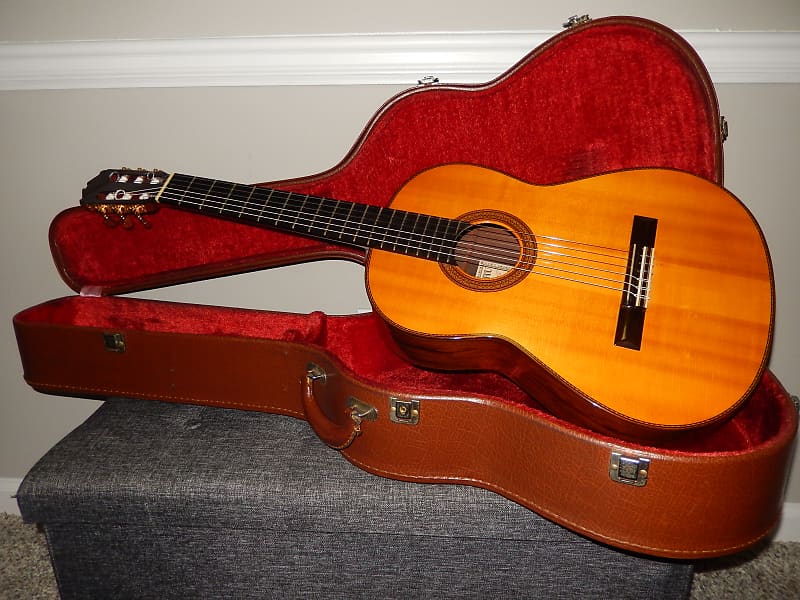

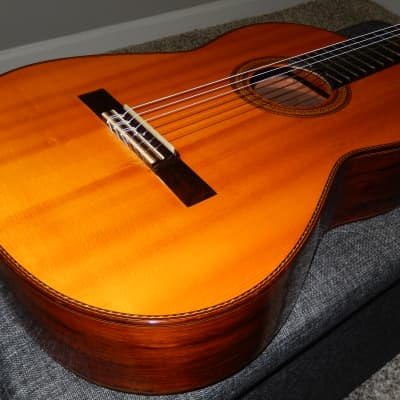
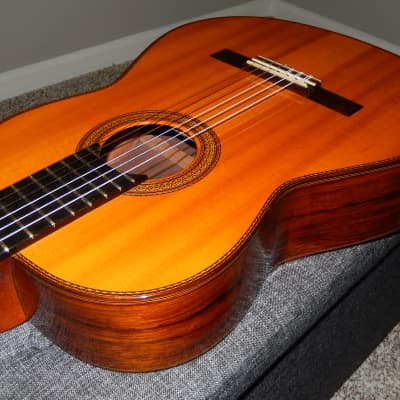
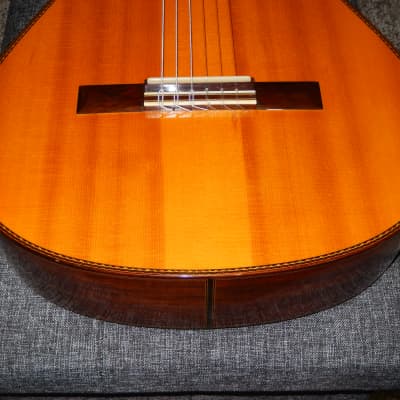
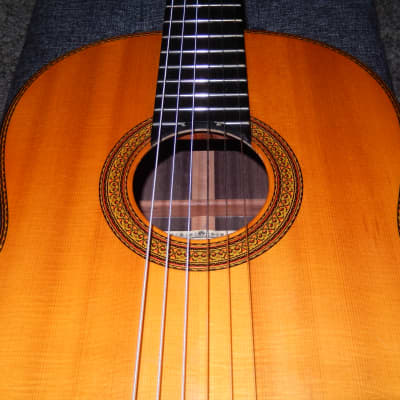
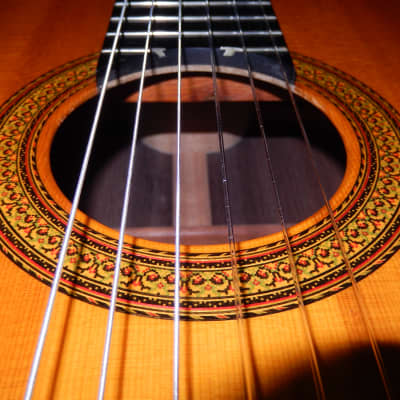
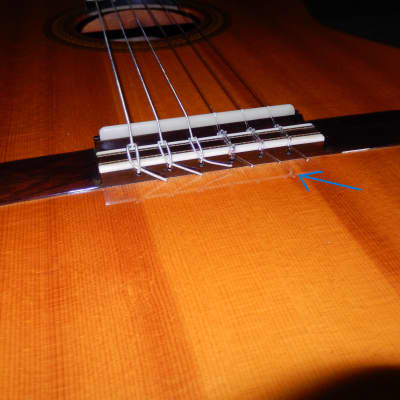
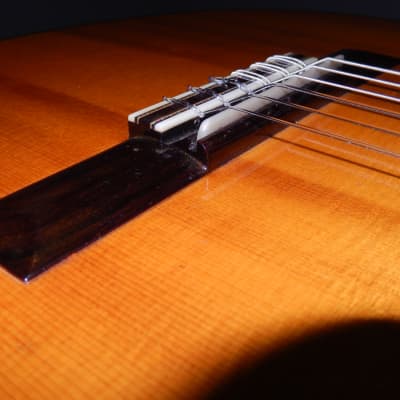
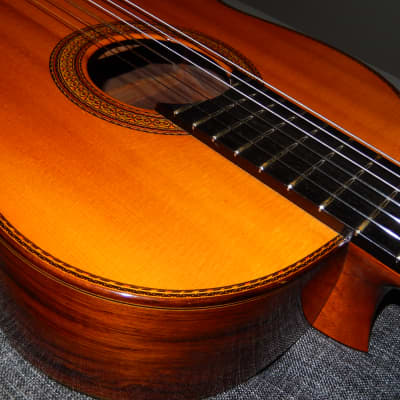
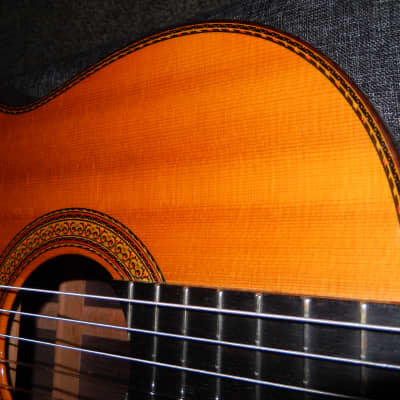
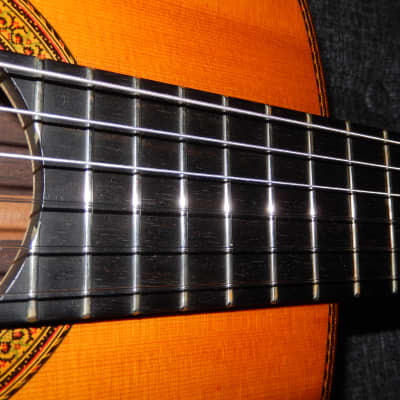
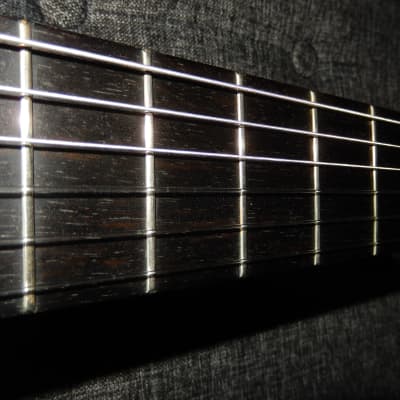
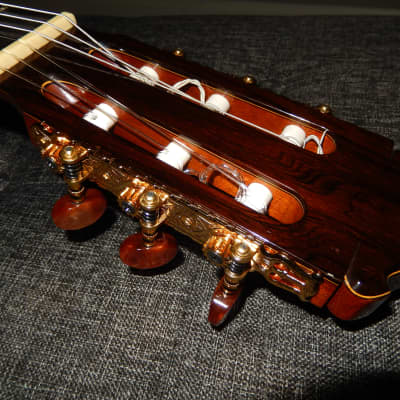
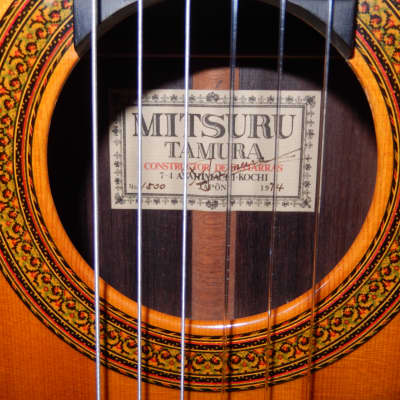
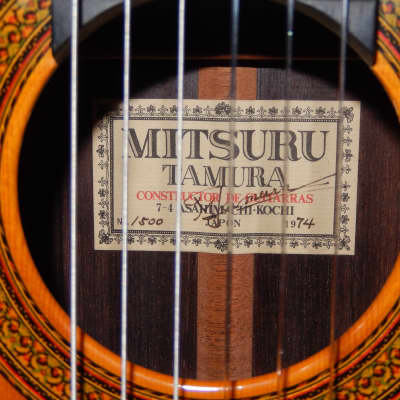
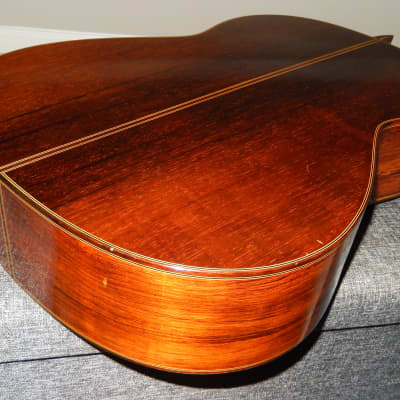
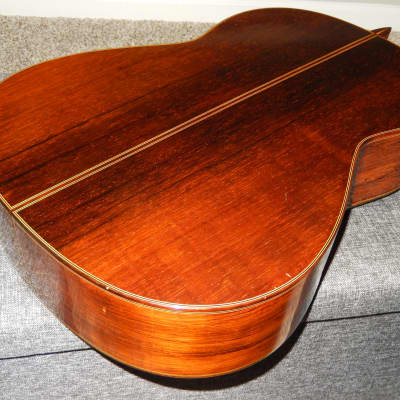
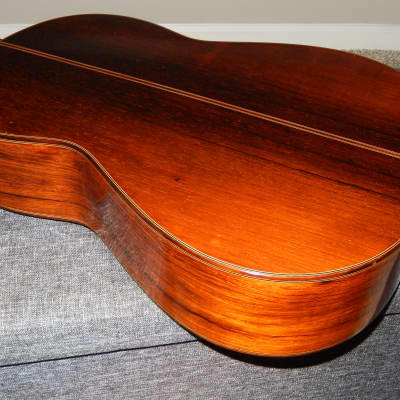
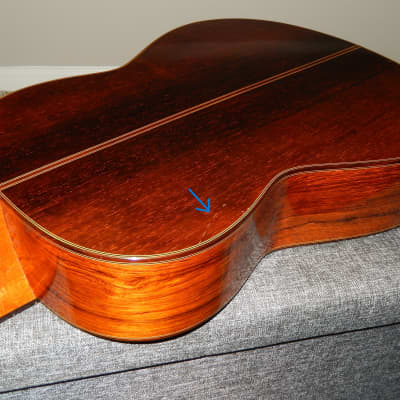
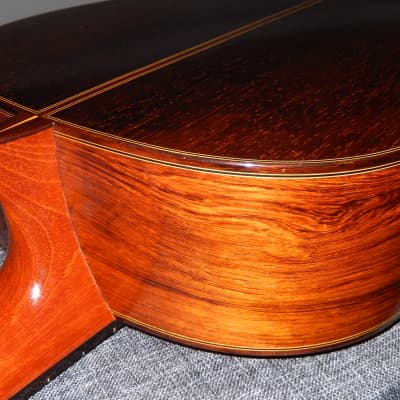
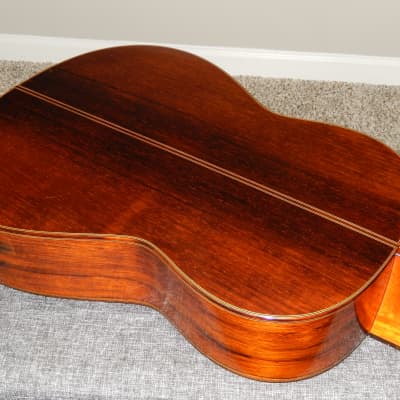
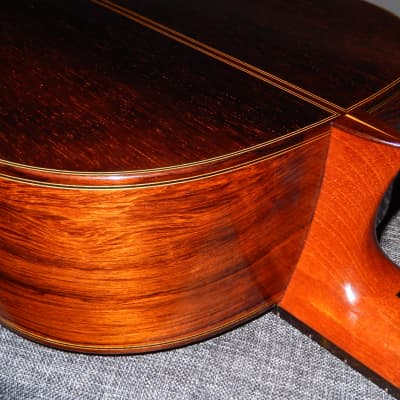
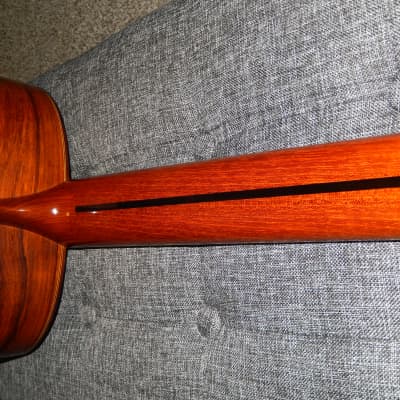
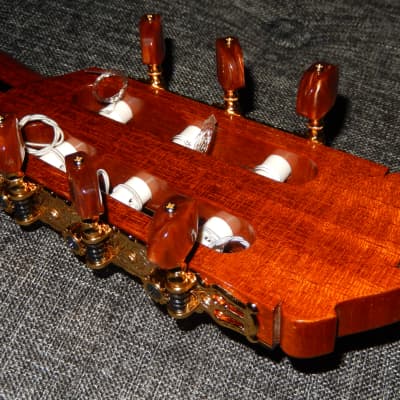
Several hundred guitars I have sold in the past are presented at Facebook.com/Victors.Guitar.Library.
MITSURU TAMURA 1500 1974
This guitar was made in 1974 by Mitsuru Tamura, a brother of better known in the West, Hiroshi Tamura. Both brothers will forever belong to Japanese Elite of Luthiers.
Just like many other famous Japanese luthiers of that era, Hiroshi and Mitsuru Tamura have learned their craft during their stay in Spain in late 1950s/early 1970s. After their return from Spain Tamura brothers were making superb quality flamenco guitars that easily challenged guitars made by the most famous Spanish luthiers. Their flamenco guitars have earned them international recognition and were played by many professional players. Although these are very hard to find, their oldest flamenco guitars were made in 1962. Strangely enough, their oldest classical guitars available on Japanese secondhand market were made in 1967.
It is quite possible that, during 1960s, both brothers shared the same workshop located in Kochi, Japan. Although both brothers were equally skilled, it was Hiroshi who has gathered more international and domestic rewards. As a matter of fact, Hiroshi’s rewards outnumbered those collected by Masaru Kohno.
In 1972 Hiroshi was financially rewarded by Japanese Ministry of Technology. Soon after, he moved to another shop, but not far from his brother’s, hired several associates and started to make his P and C models in greater numbers, successfully exporting many of them outside Japan. Only the very top models Hiroshi was making by himself.
Mitsuru Tamura has continued to work as an individual luthier, and with just couple of apprentices, was making about 15-20 guitars a month. As the result Mitsuru’s guitars are harder to find on Japanese secondhand market and they are often sold at higher prices than guitars made by Hiroshi.
Sometime in 1976, after his “factory” started to produce great financial losses, Hiroshi had to declare bankruptcy and moved back to smaller workshop, making fewer number of guitars with just couple of helpers.
The Tamura brothers passed away sometime in 1985/86. Just like in case of their superb flamenco guitars, their classical guitars are equally regarded in Japan.
This guitar was priced 150 000 yen in 1974, just like Masaru Kohno No15, Sakazo Nakade 1500, Toshihiko Nakade 1500, Hiroshi Tamura P150 etc. all made with solid BR b/s. These instruments were quite expensive for average Japanese players but still very affordable to many international players. In Japan of 1970s Mitsuru Tamura was regarded as highly as Masaru Kohno. In 1974 Masaru Kohno top of the line model was No30, and Mitsuru also had his priced 300 000 yen model 3000, while Hiroshi’s top model was P200.
It is very important to mention that by the end of 1970s, due to changes in World’s and Japanese economies, as well as new currency exchange rates, guitars made by Japanese luthiers and Gakkis became too expensive for many international importers. In those years, only a few top luthiers and Gakkis (like Masaru Kohno, Sakazo Nakade and Yamaha Co.) having very strong position on international markets, were able to freely raise the prices for their very top luxurious models. Great majority of other Japanese Top luthiers had to price their guitars far more moderately even though they were of the same quality. Nevertheless, by the end of their careers (1985/86) both Hiroshi and Mitsuru Tamura were able to sell their custom guitars at prices higher than prices of Masaru Kohno’s top of the line models.
This 1500 guitar from 1974 not only rivals Kohno #15 from that era, but also far more expensive classical guitars made in Spain and everywhere else. It is a rare find and true gem.
This guitar produces truly “Spanish” sound yet with its romantic and mystique tonality it easily beats guitars made by very famous Spanish makers of any era. It is a very responsive and powerful instrument, with deep but also quite focused basses that are colorful and sweet with only a hint of metal in them, sweet round trebles, all with high level of clarity and separation, all well balanced, and magnified by an impressive sustain. Its chords sound very transparent.
While its overall condition can be described as very good for its age, this guitar comes with few cosmetic flaws: several very light scratches (not visible on the pictures but visible from a close distance while flipping the guitar against the light) and few dents (with couple string burns below the bridge being the most conspicuous ones), few scratches and dents on its back and sides (with most conspicuous one pointed by the blue arrow). Despite all these cosmetic flaws this guitar doesn’t look as if it has been played a lot. Its straight neck, fingerboard and frets remain in very good condition. The only non-original parts on this guitar are the saddle and brand new Gotoh tuners.
Specifications:
Top: High Grade Solid “bear claw” Spruce Top/shellac
Back and Sides: Highest Grade Solid Brazilian Rosewood/shellac
Neck: Mahogany with Ebony insert
Fingerboard: Ebony
Nut and Saddle: Bone
Nut Width: 52.50 mm
Scale: 650 mm
Strings: Magma Nylon Cristal Medium Tension
Action is set to 3.50 mm under E6 and 3.00 mm under E1, with a lot of extra room on the saddle.
It will be shipped in used original case in still very good condition.
Real Value of Japanese Vintage Guitars
The key to understand value of vintage Japanese guitars is to acknowledge galloping price inflation (devaluation of Japanese yen) during 1960s & 1970s. This inflation slowed down in the 1980s.
During 1960s and most of 1970s model numbers of Japanese guitars were strictly interconnected with their prices in Japanese yen. By the early 1980s and during following decades model numbers were no longer strictly associated with their prices. Some Japanese guitar makers introduced model names instead of model numbers. Others were still using model numbers with the addition of letters and/or other symbols.
It is then important to understand that two Yamaha GC10 guitars made 10 years apart are two instruments of totally different class. The same applies to any other Japanese maker/brand.
The logical way to estimate the true class of any given Japanese made instrument is to compare its price with the average annual salary of wage workers in Japanese private sectors. This salary was: 450 600 yen in 1965 - 825 900 yen in 1970 - 1 868 300 yen in 1975 - 2 689 000 yen in 1980 - 3 163 000 yen in 1985 - 3 761 000 yen in 1990 - 4 107 000 yen in 1995 - 4 082 000 yen in 2000.
Any guitar priced 100 000 yen in 1970 (labelled as No10 or No100) would be priced 200 000 yen in 1975 (relabeled to No20, No200 or 2000), 300 000 yen in 1977 (labelled as No3, No30 or 3000) and 500 000 yen by 1985 (labelled as No50 or 5000).
Starting in 1977 Masaru Kohno introduced his new models No40 priced 400 000 yen and No50 priced 500 000 yen. By early 1980s Kohno started using model names instead of numbers and was steadily raising their prices without changing model labeling. His very top model 50 became model “Special”, and a decade later it became model “Maestro”. Naturally, all other Japanese guitar makers were doing similar pricing (labelling) upgrades.
Knowing all of that, you can bet on that Masaru Kohno No50 made in 1982 is practically the same grade instrument as Kohno No20 made in 1972, or Kohno no 30 made in 1975.
In the early 1970s the lowest Ryoji Matsuoka (all plywood) model was 10, followed by (solid top) models 15, 20, 25, 30, 40, 50, 60, 80 and (all solid woods) models 100 and 150. Models 50, 60 and 80 were made with non-solid figured Brazilian Rosewood (double) back and sides and top model 150 was the only one made with solid figured Brazilian Rosewood b/s.
In 1980 the lowest Matsuoka model was (all plywood) 20, followed by (solid top) models 30,40,50, 60 and all solid woods models 80,100,150 and 200. By 1990 the lowest Matsuoka model was M40 and the highest was M300. By 2010 the lowest Matsuoka model was M50, and the top model was M270.
You can bet that Ryoji Matsuoka model 50 from 1980 is of the same grade as model M100 from 2000, model 100 from 1980 is of the same grade as model M150 from 2000, model 150 from 1980 is of the same grade as M200 from 2000 and model 200 from 1980 is of the same grade as model M300 from 2000.
It is important to mention that if modern era luthiers are using 40+ years old woods to make an “all solid” wood classical guitar, its price is minimum $8000.
All vintage guitars made with Brazilian Rosewood are especially precious, including those made straight grain varieties and those with non-solid b/s.
Because response and tonal properties of Spruce soundboards are improving over time, long seasoned Spruces are far more precious than long seasoned Cedars.
It is not very difficult to find out what are current prices of such guitars made by the world’s leading luthiers.
Important message for Australian buyers:
USPS International Priority Mail packages destined for Australia have quite restricted size (max. length is 42” and max. length + girth is 97”). For these reasons I must use the case that is no longer than 41” and therefore it may be different than the one you see on the pictures. You should ask me for any other details prior to making a purchase.
Reverb Buyer Protection
Reverb has your back if your item is lost, damaged, or doesn't match its description. Simply report any issues within 7 days and we'll help you get a full refund.Learn more about Reverb Buyer Protection.
| Listed | 3 months ago |
| Condition | Very Good (Used) Very Good items may show a few slight marks or scratches but are fully functional and in overall great shape.Learn more |
| Brand | |
| Model |
|
| Finish |
|
| Categories | |
| Year |
|
| Made In |
|
| Body Shape |
|
